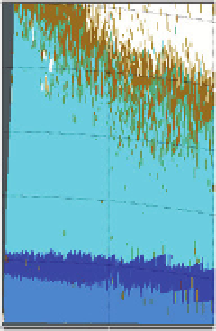Geoscience Reference
In-Depth Information
When implementing published algorithms to new environments, it is wise to compare the
hardware used in the original development work to the platform where it will be
implemented. Research community has used S-band radars a lot, while the operational
weather services in cold climates use mainly C-band. There may be also difference between
simultaneous and alternating transmission of the dual polarization channels.
5.1 Hydrometeor classification
Polarimetric properties of wet snow and single snow crystals are very different from the
ones in rain. Hence, these two snow categories are easily distinguishable from rain.
However, discrimination between stratiform rain and dry snowflakes (aggregates) is
challenging, as relatively low Z and ZDR, and high RhoHV are typical for both (Ryzhkov &
Zrnic, 1998). A typical solution in this case is to use the information of height of melting
layer, either from sounding, NWP model or radar measurements.
Decision boundaries for dense snow, dry snow, wet snow, rain, dry graupel, wet graupel
rain and hail co-existing and hail alone using Z, ZDR, RhoHV, LDR and KDP have been
published by e.g. Straka and Zrnic (1993). In many of the parameters, the selected classes
overlap, which has encouraged researchers to try fuzzy logic (Bringi & Chandrasekar, 2001).
In Fig. 5 we see RHI scans in the same situation as in Fig. 1. The 0 ºC isotherm is at 2 km, and
a layer of melting snow can be seen below it.
Fig. 5. RHI scans north of Vantaa radar 30 August 2009 00:45 UTC. . Range 100 km, height 10
km, parameters from left to right: Hydrometeor classification, reflectivity Z, differential
reflectivity ZDR and copolar correlation factor RhoHV.
5.2 Snow types
In the JPOLE classifier for cold season Ryzhkov et al. (2005) distinguished between Dry
aggregated snow: DS and Wet snow: WS, and single crystals. In some cases, this
distinction can be made using reflectivity and differential reflectivity alone: wet snow has
typically larger reflectivities, and individual crystals larger differential reflectivities.
However, the variability of both parameters for both classes is large, and the definitions
tend to overlap.





